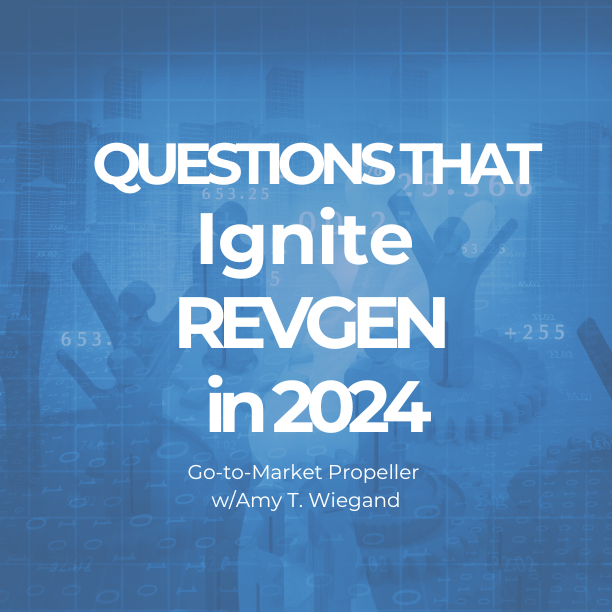
By Amy T. Wiegand
Start-ups often must move fast, and feeling the pinch to move fast, teams skip planning steps. Yet, skipping the planning process may slow us down in the long run.
The Harvard Business Review and Business School found that B2B teams who clearly understood the organization’s plan or strategy were 67% more likely to outperform their peers regarding revenue growth, yet 48% of leaders spend less than one day per month discussing the strategy.
Like all great coaches, our leaders are responsible for igniting a fire in our teams to win and understand how our past plays can help us score big on our future goals.
- Understand past wins/losses and focus on what works and who is in the market to buy.
- Understand the market & your buyer.
- Align the strategy between the sales, marketing, product, and customer success teams.
- Rollout the plan to the entire organization for ownership and accountability of all.
Doing it right from the beginning means we do not have to do it again, which saves time. As start-up leaders, we must also plan for pivoting – Plan B and C. The best advice is to test what works, fail fast, and move on. Here are a few questions to help kick-start your team to drive profitability in 2024 and beyond.
Questions to Ignite RevGen in 2024
Market, Buyer, and Competitor Understanding:
- What is our current market position, and how has it evolved?
- Are there emerging trends or shifts in buyer behavior?
- How well do we understand our target audience and their needs?
- What markets and segments will be a target in the short term? Long term?
- How is our brand perceived in the market, and is it consistent with our desired image?
- Are there any negative perceptions to address?
- What efforts can we take to build and maintain a positive brand image?
- Who are the organization’s designated storytellers? Align them.
- Who are our main competitors, and what are their strengths and weaknesses?
- Are there new entrants or disruptive forces we need to be aware of?
- How do we differentiate ourselves from competitors in the market?
ROI and Performance Metrics:
- How did our revenue metrics across markets and segments perform? Break it down and analyze it. E.g., Closed-Won & Closed-Lost Rates, Average Customer Lifecycle (ACV), Sales Cycle Length, Churn Rate, Year-over-Year, Pipeline Adoption, Pipeline Acquisition, etc.
- Who are the new logo targets? What are their revenue benchmarks?
- What key performance indicators (KPIs) can we measure success in 2024?
- How is the return on investment (ROI) assessed?
Customer Acquisition and Retention:
- How, who, and what drove the fastest deals in 2023?
- Who was involved in the purchasing decision? What were their roles? What are their goals? What questions did they have? What influenced their decision? What triggered their buying process?
- Are there areas where we can optimize marketing spend for better results?
- Are there new channels or platforms we should consider for reaching our target audience or ideal customer profile (ICP)?
- What channels provided non-ICP inquiries, and do we improve upon this?
- Why did we lose opportunities, and how can we improve upon this?
- Are our core marketing processes optimized and operationalized, or are they reactive to random requests?
- How responsive are we to changing customer preferences?
- How are we retaining existing customers?
- How do we define customer success?
- What is our customer success rate?
- Are there any notable customer insights that could inform future marketing efforts?
- How responsive are we to changing customer preferences?
- Are there opportunities to upsell or cross-sell to current customers?
- Who are the new logo targets? What are their revenue benchmarks?
- Who are channel partners?
- Who and what programs can we align with to provide optimal customer acquisition and retention?
Team Collaboration:
- How closely aligned is our RevGen team – Are Sales, Marketing, Product, and Customer Success aligned? Do they know what the other is working on?
- What are the organization’s priorities, and how do those affect multi-team priorities?
- What strategies are in place to improve collaboration between teams?
- What are the friction points and challenges? How can they be resolved?
- Are we hiring the right employees and contractors?
- How do we need to hire, upskill, train, and inform our teams that fast performance is required?
Innovation and Technology:
- What innovative approaches or technologies are being explored to leverage our data for better decision-making?
- Are there opportunities for automation or improved technology?
- How can we use generative AI with integrity to help our teams move faster?
- What tech is not optimized for use? Is it creating obstacles? Do we optimize it or get rid of it?
Short-Term Considerations:
- What is our current financial status, and how can each employee contribute to organizational efficiency improvements?
- What organizational efficiency improvements can we make today?
- How is our strategy contributing to the company’s short-term growth plans? 30/60/90?
- What adjustments must be made for short-term gains while planning for long-term ones?
- Do we need to offer a short-term promotion, loyalty program, trial offer, or freemium model for long-term gains?
- Who is in the market to buy now? Are we leveraging in-market opportunities? Do we know how to find in-market opportunities?
The above questions and many more can serve as a starting point for comprehensive team discussions and efforts with overall business objectives that drive future revenue. Good luck!
